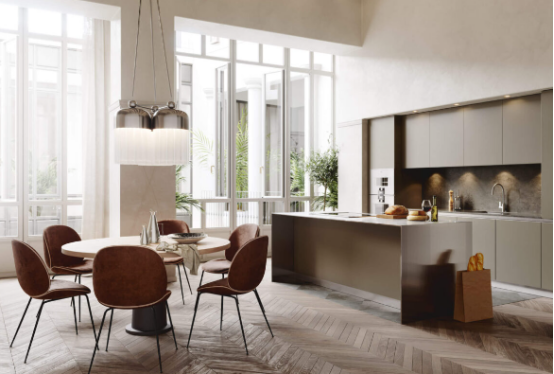

Many customers find it confusing to differentiate between PVC flooring, LVT flooring, SPC flooring, and WPC flooring, as they are often unsure about how these types of flooring differ from traditional PVC plastic flooring.
To understand what LVT, SPC, and WPC flooring are, we must start with PVC flooring. PVC flooring, commonly known as plastic flooring, is a broad term that encompasses any flooring made from polyvinyl chloride. LVT, SPC, and WPC flooring are all subcategories of PVC flooring. They are created by incorporating different additional materials into the base PVC, resulting in distinct subcategories.
l LVT flooring, also known as Luxury Vinyl Tile flooring, is a flexible and resilient type of flooring. It can even be rolled up. The market price of LVT flooring ranges from a few tens to a few hundred yuan. In the past, it was mainly used in commercial projects due to its high flooring requirements and the need for professional installation. Therefore, considering the cost, it is usually suitable for large-scale installations.
l SPC flooring, which stands for Stone Plastic Composite, belongs to the category of rigid plastic flooring. It can also be bent, although not as much as LVT flooring. SPC flooring is commonly known as stone crystal flooring, plastic stone flooring, or stone plastic flooring in Hong Kong, Taiwan, and other regions. Besides being popular in Europe and America, Southeast Asia is one of the areas that extensively uses SPC flooring. This is because it not only has high aesthetic value but also boasts excellent waterproof and moisture resistance properties. Furthermore, its installation cost is lower and requires less time compared to laying tiles.
l WPC flooring, or Wood Plastic Composite flooring, is a semi-rigid type of sheet plastic flooring commonly referred to as wood-plastic flooring. WPC flooring incorporates wood powder into its composition. However, some WPC flooring options no longer contain wood fibers and can be considered as stone plastic flooring.
PVC flooring primarily consists of polyvinyl chloride.
LVT flooring is primarily composed of polyvinyl chloride with a small amount of calcium carbonate powder. It is a semi-rigid sheet flooring.
WPC flooring is composed of polyvinyl chloride and wood powder. It is also a semi-rigid sheet flooring.
SPC flooring is composed of 25% polyvinyl chloride and 75% calcium carbonate powder. It is a rigid sheet flooring.
PVC flooring can be used in various spaces such as homes, hospitals, schools, malls, factories, and offices.
LVT flooring is commonly used in schools, kindergartens, playrooms, and offices.
WPC flooring is mainly used outdoors, with limited indoor applications, distinguishing it from the other three types.
SPC flooring is suitable for homes, hotels, restaurants, schools, hospitals, and other spaces.
WPC flooring can achieve a thickness of over 8mm. SPC flooring is typically 4-7mm thick, while LVT flooring is generally less than 5mm thick. PVC flooring usually comes in thicknesses of 2mm or 3mm.
PVC plastic flooring is available in roll form and is suitable for large-scale installations, as it is easy and convenient to lay down.
LVT flooring offers various installation methods depending on the product style, including glue-down and click-lock options.
WPC outdoor flooring requires a more complex installation process, involving fixing the substructure before assembling the WPC boards.
SPC flooring utilizes a click-lock design, making it simple to install, even for DIY projects.
By understanding the differences between PVC, LVT, SPC, and WPC flooring, customers can make informed decisions when selecting the most suitable flooring option for their specific needs.